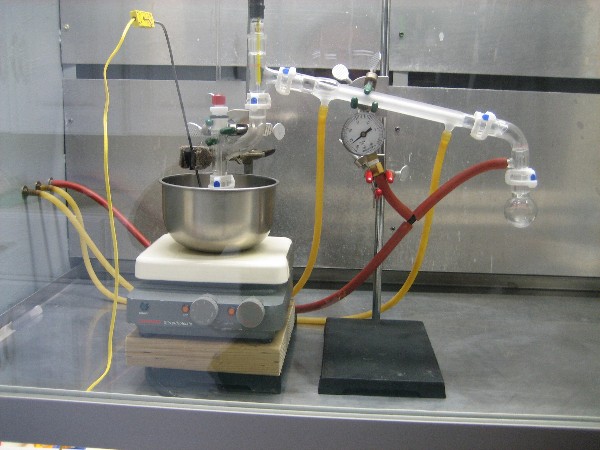Preparation of Diethyl Malonate
Preparation of Diethyl Malonate
1/25/10
by Magpie
Introduction
Diethyl malonate (DEM) is useful for the synthesis of alkylacetic acids, R-CH2-COOH. This procedure provides for the synthesis of ~12mL of DEM from
malonic acid and ethanol using a Fischer esterification. A small amount of sulfuric acid is used as catalyst. Absolute ethanol is used in an
azeotropic distillation to remove byproduct water thereby promoting a more favorable equilibrium. The yield, however, is only 53% (see discussion
below).
Reagent Preparation
Weigh out 15.4g of malonic acid.
Prepare 200mL of anhydrous ethanol. A convenient method for doing this is to place12.2g of 3A molecular sieves in each of two 125mL bottles. Top
these off (leaving some head space) with 95% ethanol, cap, and leave overnight.
Have available the following reagents: concentrated sulfuric acid, dichloromethane or ether, Na2CO3, and NaCl.
Equipment Setup
Set up for simple distillation using a 250mL round bottom flask (RBF) as pot. Use a Claisen adapter with a glass sparge tube installed in the short
center leg. Use a 250mL beaker as a receiver. Set up an oil bath for heating the pot. A hotplate with a magnetic stirrer is useful here to heat the
bath. Provide ice-cooled water for the condenser.
Set up a separate 500mL RBF as an alcohol vaporizer. Connect the vapor tube with rubber tubing to the glass sparge tube. Use a 500mL, 270w Glas-Col
heating mantle (or equivalent) to heat the vaporizer.
Esterification with Azeotropic Distillation
Place the malonic acid in the pot. Add 65mL of absolute ethanol and 0.6mL of conc sulfuric acid. Swirl to dissolve the malonic acid. Add a small
magnetic stir bar and reconnect the pot to the condenser.
Add a second magnetic stir bar to the oil bath. Place the pot in the oil bath and set the bath temperature at 105°C. Set the magnetic stirrer for
gentle stirring of both the RBF and the oil bath. Turn on the cooling water.
Place 120mL of absolute ethanol in the vaporizer RBF. Set the mantle heat at 30%, adjusting as necessary to sparge alcohol vapor into the bottom of
the pot. Sparge in all of the ethanol in the vaporizer at the same time ethanol/water is being distilled to the receiving beaker. When the vaporizer
is empty, raise the oil bath temperature to 115°C and continue the distillation until no more ethanol/water is coming over. There will be about 30mL
of crude DEM left in the pot.
Workup
A. Neutralization and Washing
Place the pot contents (the product) in a 125mL separatory funnel with a little chipped ice. Wash out the pot with a little dichloromethane or ether
and add this to the separatory funnel.
Using a saturated aqueous solution of Na2CO3 neutralize the product in the separatory funnel by adding a little at a time then shaking. Be sure to
allow for the escape of CO2 by frequent venting of the funnel. Add enough of the Na2CO3 solution to make the product distinctly alkaline, checking it
periodically with pH paper. Separate the aqueous layer from the organic layer, discarding the aqueous layer.
To the organic layer in the separatory funnel add 25 mL of saturated aqueous NaCl, and shake to wash, but not too aggressively to avoid the formation
of an emulsion. Upon setting a fairly clean interface should result. Separate the lower aqueous layer (sp gr = 1.2) and discard.
B. Vacuum Distillation
See Note 1.
Place the crude DEM product in a 50mL RBF and set up for vacuum distillation. Use of a magnetic stir bar and/or an ebulliator tube is recommended to
prevent excessive bumping. If an ebulliator tube is used use a Claisen adaptor and place the thermometer in the distillation adapter. Use of a
vacuum suckback safety bottle and a pressure indicator are highly recommended. Use the oil bath as a heat supply.
Initially set the oil bath temperature at 80°C and begin vacuum distillation. When all the low boiling impurities have been removed, stop the
distillation. Replace the receiver with a 25mL RBF.
Now set the oil bath temperature at 140°C and resume the vacuum distillation. The product DEM should come over at a distillate temperature of
90-100°C, depending on the strength of your vacuum (Note 2). Yield will be about 12mL. The product will have a subtle smell of a fresh cut apple.
Discussion & Conclusions
The reference cited below provides a study of several methods for increasing yield, 2 of which I tried. The authors of this study reported yields
from 76.2 to 96.11%. The 1st method I tried is that shown above, ie, azeotropic distillation. The second method I tried (experiment C-2 of Table II)
was to conduct the esterification at 50°C. Unfortunately the results of this method are obscured by a suckback that occurred during vacuum
distillation. A yield of 34% was obtained. A 3rd method, not shown in the reference, was tried and intended as a baseline. Here no sparging was
used and the esterification consisted of refluxing of 23g of malonic acid with 100mL of ethanol for 4 hours. Yield was only 36%.
Notes
1. This procedure presumes that a cold water driven aspirator is the source of vacuum, and that the resulting pressure is 50-75mmHg.
2. The normal boiling point of diethyl malonate is 199°C.
Reference
1. American Journal of Science, 1908, 4th series, vol. XXVI, No. 153, Supplement: Art. XXV, “On the Esterification of Malonic Acid, “by IK
Phelps and EW Tillotson, Jr.

[Edited on 25-1-2010 by Magpie]
The single most important condition for a successful synthesis is good mixing - Nicodem
|